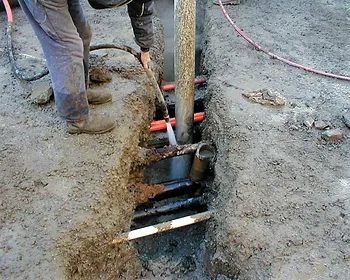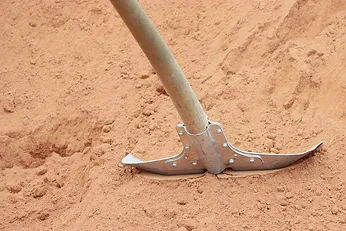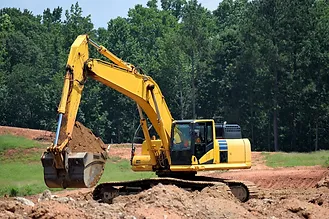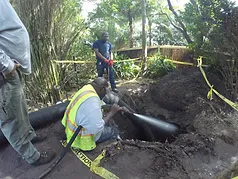What is Utility Potholing?
Utility potholing, also known as daylighting, is an excavation process that involves making a series of small test holes in order to accurately locate underground lines.
Potholing can tell workers a lot about buried utility lines, including :
- Horizontal position
- Depth
- Type of line
- If there are any signs of damage to it
Nowadays more work crews are regularly using potholing to avoid hitting water, electrical, gas, telecommunications, and fiber optic lines and help keep projects within budget and on schedule. It is also an effective technique for applications requiring boring holes, such as :
- Installing signage
- Placing telephone or utility poles
- Posting fences
Potholing Methods :
Potholing can be carried out in a variety of ways depending on your project requirements, budget, and level of risk associated with the intended works. There are a few methods of potholing that are implemented in the construction industry today :
Hand Digging :
This method employs the use of hand tools, such as shovels and digging bars, to manually uncover and remove excavated material. Though this method is generally the least costly, as expensive equipment is not warranted, it is incredibly time-consuming and labor-intensive. Hand digging is suitable for applications where working space is limited and access restricted.
expensive equipment is not warranted, it is incredibly time-consuming and labor-intensive. Hand digging is suitable for applications where working space is limited and access restricted.
Hand digging is generally considered a safe method of potholing, as the equipment used is not likely to rupture an underground pipe. However, caution should be exercised when digging near to electrical lines and fiber optics.
Backhoes :
The digging of potholes with backhoes was once the most popular method of potholing. However, due to the risk involved with this method, its popularity has waned. Backhoes are used in applications where precision is not significant, such as new housing developments, where the probability of utility interference is low. Due to its size and bulky nature, backhoes are not suitable for applications where there are space limitations.
suitable for applications where there are space limitations.
Excavating with a backhoe is an inexact method; therefore, operators run a very high risk of damaging the utilities that they were tasked to expose. If backhoes are used in potholing exercises, a spotter must be used for the duration of the process. The spotter is tasked with observing operations and communicating with the backhoe operator once he sees any evidence of utilities.
Hydro Excavation / Vacuum Excavation :
High-pressure water is applied to loosen and dig the land in this method. This creates a mud slurry that is housed in a spoil tank through a vacuum. Holes created are typically in range of that of the vacuum excavation process. A vacuum device then collects the soil. Aside from preventing damage to utilities, vacuum excavation is efficient, precise, provides a safer working environment, and is cost-effective.
environment, and is cost-effective.
Hydro excavation is suitable for potholing use throughout the year as heated water can be used on cold/frozen ground conditions and various other soil types and conditions. Caution must be taken when implementing water vacuum excavation as the high pressure can result in damage to cables and pipelines.
Using these two methods in tangent is the preferred potholing method by contractors. With Wind River Environmental, these methods are done together with one rig.
What Utility Potholing Method is Best?
Potholing is one of the most effective methods of utility location as compared to other methods such as reading maps and charts that can be out of date. The exact position of utilities can shift over time due to factors, such as settlement. Potholing negates the risk of improper location, once the proper technique is used, as it is an onsite operation that can be controlled and tracked.
Of all the methods of potholing, hydro excavation/vacuum excavation tends to be the most popular procedure, as it is considered safer than hand-digging or using a backhoe machinery, due to its non-invasive nature. The use of this method also bodes well for all parties involved as the likelihood occurrence of threats, such as loss of life, project delays, service outages and negative cost implications, are reduced.
Is Utility Potholing With Hydro Excavation Worth It?
YES, hands down! Hitting a gas line or utility pipe with a backhoe, trencher, or horizontal directional drill could be catastrophic. Think about it, if you hit a water line that feeds into a hospital, it could be down for hours or even days. You or your company wouldn't want to be responsible for those damages, I promise you. The cost of damages far exceeds the cost for hydro excavation.
How Much Does Potholing Cost?
The costs vary depending on a wide array of factors during the excavation process, which include but are not limited to :
- How many holes are being excavated
- The depth and size of each hole
- The proximity to water and disposal site (depending on the location of each could delay the excavation productivity and the job could take hours longer than originally intended)
- Disposal costs
These are just a few factors the contractor has to take into consideration before being able to factor in a price. At Wind River Environmental we are here for all your potholing needs and if you call us today, one of our potholing contractors would be happy to assist in giving you a quote for the job.



